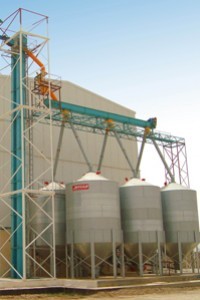
On July 25, 2011, the Iraq Grandparents Feed Mill opened for business becoming the fifth feed mill upgraded to international standards by the USAID-Inma Agribusiness Program.
In 2009, the USAID-Inma Agribusiness Program determined that an important intervention for the Livestock–Protein sector was to improve the quality of feed available to Iraqi producers. To address the problem, six feed mills in different provinces were chosen for production improvements.
To date, five feed mills are in operation and one is under construction. Each feed mill will increase production to 20,000 MT/year, making the livestock industry more competitive and efficient.
The Iraq Grandparents Feed Mill, located in Diyala province, will provide a valuable service to the surrounding community as the livestock industry in Iraq currently requires 1.1 million MT of feed per year. Approximately 425 poultry farms are located in Diyala. These farmers will now have convenient access to quality poultry feed.
The new mill is producing high quality poultry feed for this local market as well as other types of livestock feed.
"This feed mill is one of a kind in Diyala, it is located near the border with Baghdad province and thus will be able to service farmers in both provinces. It has a large production capacity (10 tons/hour) and raw material storage" said the USAID-Inma livestock specialist.
The USAID-Inma Program is providing ongoing technical assistance to all six feed mills, USAID-Inma economists and feed nutritionists have worked with each of the six mills to identify and price numerous locally available feed ingredients and to develop balanced feed rations for local producers.







Comment
Make a general inquiry or suggest an improvement.